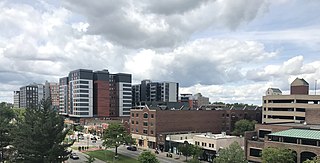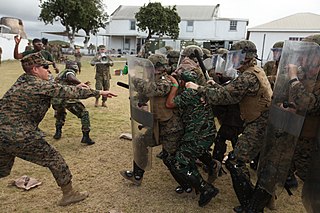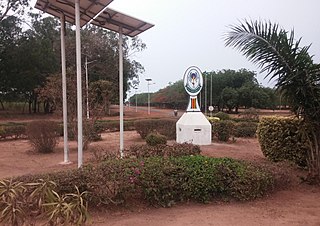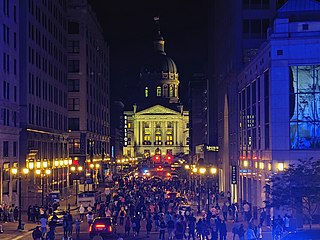This article may need to be rewritten to comply with Wikipedia's quality standards.(December 2013) |
Cedar Fest was an annual festival held in East Lansing, Michigan, between 1983 and 1987.
This article may need to be rewritten to comply with Wikipedia's quality standards.(December 2013) |
Cedar Fest was an annual festival held in East Lansing, Michigan, between 1983 and 1987.
The event, which started in the 1970s, was started by Paul Stanley who was the head of pop entertainment which was Michigan State University‘s student entertainment board. Pop entertainment had made a large sum of money that year and it was a means that Paul created to basically give back to the students. Cedar fest was to be a beautiful spring day down by the Cedar River with live known bands. The first year hosted mainly folk guitar acts and drew around 8000 students that enjoyed the beautiful day at the Cedar River. The following year cedar fest Drew approximately 10,000 to 12,000 people to The cedar river banks for the concert. The event was held in Cedar Village, a densely populated student neighborhood bordering the Michigan State University campus. The event took off in the 1980s and was regularly attended by thousands. Several riots ensued from the parties and property owners along with the city decided to put an end to the event. In 1987 the event was banned by an injunctive order issued by Judge Carolyn Stell. For many years it was not held. [1]
Cedar Fest saw a revival in 2008, 21 years after the city had officially banned the event. The revival, which began as a campaign on Facebook as early as January, promised a "weekend long party" that would take place "throughout all of Cedar Village." [2] It drew up to 4,000 party goers and was officially declared an unlawful assembly as police launched 24 smoke grenades, 20 flash bangs, 20 stingball grenades and 13 rounds of tear gas to disperse the out-of-control crowd. [1] Some revelers threw bottles, cans and bricks at police officers, while two city vehicles' windows were broken, and at least four fires were set. [2] East Lansing police Chief Tom Wibert remarked that the event "got to the point where I don’t see how we could have dispersed that crowd without tear gas." In fact, Wibert said after the police used flash bangs and smoke bombs, some students began to chant for tear gas. [1] [2] The "riot" cost close to $10,000 in damages and resulted in 52 arrests, 28 of them being MSU students. Police estimated that about 5% of MSU's student population was at the event. Not a single citizen's complaint was made against the police regarding this riot, a complete turn around from the flood of complaints which occurred following the riot after the NCAA loss in 2005.
Observers noted that police were more restrained compared to their handling of the 2005 riot after MSU's Final Four loss. In that incident, police began using tear gas just 15 minutes after crowds formed, launching 299 canisters in total. [1] Eight members of the Lansing branch of the ACLU were on hand to monitor police actions during the 2008 Cedar Fest and afterwards complimented police on how the incident was handled. [1]
At a press conference following the event, Wibert said:
It’s something that’s completely new for us. We’ve never had an incident like this instigated from a web site. As far as I’m concerned, Cedar Fest is over and we’re not going to allow it to happen again. It’s not a tradition that East Lansing or Michigan State University wants to continue. As many trouble makers from last night as we can are going to be convicted and they’re not going to be here next year. [1]
With the memory of 2008's Cedar Fest fresh in the minds of Michigan State students, an unofficial Cedar Fest revival occurred Saturday, April 4, 2009 and Monday, April 6, 2009, following the Michigan State men's basketball team's successful run to the Final Four. Crowds of 2,000 and 1,700 (respectively) peacefully celebrated together in the streets outside of Cedar Village with continuous chants of "Go Green, Go White!" and renditions of the Michigan State University Fight Song.Over 80 arrests were made during the Final Four weekend; however, most of these arrests were related to minors possessing alcohol. A total of 11 acts of arson were reported (mostly burnt couches, an MSU tradition); however, no major incidents occurred as most revelers left Cedar Village peacefully after being asked to disperse by the police.[ citation needed ]
In 2013, students gathered at the Cedar apartments to celebrate MSU's victory in the Big Ten football championship game. After four large fires were fed with various furniture and household items for several hours, police moved in to disperse the revelers. [3]
On March 29, 2015, after MSU advanced to the Final Four by defeating Louisville in the Elite 8 of the NCAA basketball tournament, hundreds of students gathered outside Cedar Village to celebrate. Police were immediately on the scene. Students began throwing dozens of bagels in the air in jubilance and a sweater was burned. Several arrests were made. [4]

East Lansing is a city in the U.S. state of Michigan. Most of the city lies within Ingham County with a smaller portion extending north into Clinton County. At the 2020 Census the population was 47,741. Located directly east of the state capital of Lansing, East Lansing is well-known as the home of Michigan State University. The city is part of the Lansing–East Lansing metropolitan area.

Michigan State University is a public land-grant research university in East Lansing, Michigan. It was founded in 1855 as the Agricultural College of the State of Michigan, the first of its kind in the United States. After the introduction of the Morrill Act in 1862, the state designated the college a land-grant institution in 1863, making it the first of the land-grant colleges in the United States. The college became coeducational in 1870. Today, Michigan State has rapidly expanded its footprint across the state of Michigan with facilities all across the state and one of the largest collegiate alumni networks with 634,000 members.

The On-to-Ottawa Trek was a mass protest movement in Canada in 1935 sparked by unrest among unemployed single men in federal relief camps principally in Western Canada. The trek started in Vancouver and, picking up reinforcements along the way, was conducted by riding traincars eastward. The trek was stopped in Regina where on July 1, 1935 police dispersed it with loss of life and mass arrests.

The 1967 Detroit riot, also known as the 12th Street Riot, was the bloodiest of the urban riots in the United States during the "Long, hot summer of 1967". Composed mainly of confrontations between black residents and the Detroit Police Department, it began in the early morning hours of Sunday July 23, 1967, in Detroit, Michigan.

Riot control measures are used by law enforcement, military, paramilitary or security forces to control, disperse, and arrest people who are involved in a riot, unlawful demonstration or unlawful protest.

A police riot is a riot carried out by the police; more specifically, it is a riot that police are responsible for instigating, escalating or sustaining as a violent confrontation. Police riots are often characterized by widespread police brutality, and they may be done for the purpose of political repression.
Black Friday, August 13, 2004, was the crackdown by the Maldivian National Security Service (NSS) — later Maldivian National Defence Force — on a peaceful protest in the capital city of Maldives, Malé. This unplanned and unorganized demonstration was the largest such protest in the country's history. Beginning on the evening of August 12, 2004, the demonstration grew and continued until it was forcefully ended on the afternoon of August 13, 2004. Protesters initially demanding the freeing of the pro-reformists arrested on the afternoon of August 12, 2004. As the protest continued to grow, people demanded the resignation of president Maumoon Abdul Gayoom, who had been in power since 1978. What started as a peaceful demonstration ended after 22 hours, as the country's darkest day in recent history. Several people were severely injured as NSS personnel used riot batons and teargas on unarmed civilians.
Notable Michigan State University student riots occurred during the late 1990s and early 2000s (decade). The most recent riot occurred in 2021.
The 1979 Easter Sunday Herman Hill riot in Wichita, Kansas, United States – a confrontation between 500 law-enforcement personnel and the 3,500 attendees at a rock concert in Herman Hill Park – was one of the largest riots in the history of Wichita, drawing national attention and creating political and legal controversy.
The history of Michigan State University dates back to 1855, when the Michigan Legislature established the Agricultural College of the State of Michigan under the encouragement of the Michigan State Agricultural Society and the Michigan Farmer, the state's leading agricultural periodical. As the first agricultural college in the United States, the school served as a model for other institutions of its kind established in the period, to give an instance, the Agricultural College of Pennsylvania.

The campus of Michigan State University is located in East Lansing on the banks of the Red Cedar River, and comprises a contiguous area of 5,200 acres (21 km2), 2,000 acres (8.1 km2) of which are developed. Built amid virgin forest, the campus opened in 1855 with three buildings, none of which remain. As an agricultural college, the campus was originally located several miles outside of the city of Lansing, but as the population of the college grew, the city of East Lansing developed just north of the area's main avenue.
Multiple disturbances broke out on Christmas Day of 1981 and New Year's Day of 1982 in Hong Kong. Since the majority of the participants were youths, the riots were also named as the Christmas youth riots of 1981 and New Year youth riots of 1982. The riots had a long-term impact on the government's youth policy.

Palmer Fest is an annual block party in Athens, Ohio, usually taking place annually in May on Palmer Street near the city's eastern edge. Palmer Street is a major student neighborhood of Ohio University. The event regularly attracts regional attention and sparks controversy as tens of thousands of students from universities around the state gather on the street, and reportedly engage in binge drinking and other disruptive behavior.

The State Street Halloween Party was an annual Halloween festival located in Madison, Wisconsin.

The University of Lomé is the largest university in Togo. Located in the city of Lomé, it was founded in 1970 as University of Benin and changed its name to the University of Lomé in 2001.
The 2007 Terengganu riot was an incident on 8 September 2007 in Terengganu, Malaysia where a peaceful rally became violent after intervention by the Malaysian police. The police fired water cannons, tear gas, and live ammunition at the rally participants, and two protestors were injured from the police's gunshots. Following the riot, the Human Rights Commission of Malaysia announced that they would open inquiries probing into the events of that night.

Starting in May 2020, protests following the murder of George Floyd were held in the city of Portland, Oregon, concurrent with protests in other cities in the United States and around the world. By July 2020, many of the protests, which had been held every day since May 28, drew more than 1,000 participants. Protests continued into August, September, and October 2020, often drawing hundreds.

This is a list of George Floyd protests in Indiana, United States. As of July 2020, protests had occurred in at least 25 communities throughout the state.

This is a list of protests that took place in Michigan in 2020 following the murder of George Floyd.